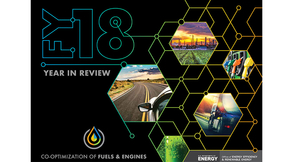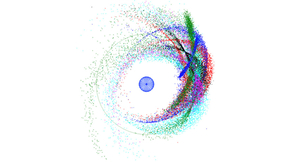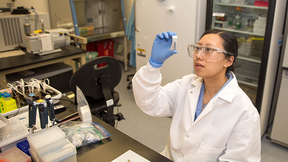Back
Physical and Life Sciences
Under pressure: New device's 1.6 billion atmospheres per second assists impact studies
A new super-fast high-pressure device at DESY's PERA III X-ray light source allows scientists to simulate and study earthquakes and meteorite impacts more realistically in the lab. The new-generation dynamic diamond anvil cell (dDAC), developed by scientists from Lawrence Livermore National Laboratory (LLNL), Deutsches Elektronen-Synchroton (DESY), the European Synchrotron…
Gemini Plus Enables Next-Generation Planetary Composition Measurements
NASA has funded the development of a new high-purity germanium gamma-ray detector—the GeMini Plus—for use in upcoming planetary exploration missions.
Co-Optima identifies six new blendstocks for improved fuel economy, vehicle performance
Three years after embarking upon a rigorous evaluation of a pool of more than 400 candidates, researchers with the Co-Optimization of Fuels & Engines (Co-Optima) initiative have identified six blendstocks from two chemical families that exhibit the greatest potential to dramatically increase efficiency when combined with petroleum-based fuels in boosted (or…
Big Data Illuminates the Physical Sciences
Astrophysics is a growth area in the Laboratory’s advancement of basic science for national and global security needs. In this field, data science helps researchers catalog and interpret objects orbiting Earth and process huge volumes of data captured by ground- and space-based telescopes.
Stellar reactions in a galaxy not so far, far away
Few people over the course of history have had a hand in discovering an atomic element. Yet nuclear chemist Dawn Shaughnessy joined a team of scientists from Lawrence Livermore National Laboratory (LLNL) and Russia that discovered five elements from 1989 to 2010. Now she leads the Nuclear and Radiochemistry Group of the Physics and Life Sciences Directorate at LLNL and…
Did comet impacts jump-start life on Earth?
Comets screaming through the atmosphere of early Earth at tens of thousands of miles per hour likely contained measurable amounts of protein-forming amino acids. Upon impact, these amino acids self-assembled into significantly larger nitrogen-containing aromatic structures that are likely constituents of polymeric biomaterials. That is the conclusion of a new study by…
High-powered laser diodes can reduce residual stress in metal 3D printed parts
In 3D printing, residual stress can build up in parts during the printing process due to the expansion of heated material and contraction of cold material, generating forces that can distort the part and cause cracks that can weaken or tear a part to pieces, especially in metals. Researchers at Lawrence Livermore National Laboratory (LLNL) and the University of California,…
Microbial growth and carbon uptake are driven mainly by nature, not nurture
For soil microorganisms, how much of their life’s work is driven by evolution (nature) versus their current environmental (nurture)? As it turns out, the evolutionary history of soil microorganisms plays a larger role in growth rates and carbon uptake, according to a new study appearing in the June 17 edition of the journal Nature Ecology & Evolution. "Our results…
Santer to receive honorary graduate degree from the University of East Anglia
Lawrence Livermore National Laboratory (LLNL) climate scientist Benjamin Santer is among scientists, authors, actors, business leaders, lawyers, surgeons and philanthropists who will be heading to the University of East Anglia (UEA) to become honorary graduates next month. "Lord of the Rings" and "Titanic" actor Bernard Hill, "Apple Tree Yard" author Louise Doughty and…
LLNL-led study finds any single hair from the human body can be used for identification
Any single hair from anywhere on the human body can be used to identify a person. This conclusion is one of the key findings from a nearly year-long study by a team of researchers from Lawrence Livermore National Laboratory’s (LLNL) Forensic Science Center (FSC) and Michigan State University. The team’s study, published in Scientific Reports, a journal of Nature Magazine,…
Turning the switch on biofuels
Plant cell walls contain a renewable, nearly limitless supply of sugar that can be used in the production of chemicals and biofuels. However, retrieving these sugars isn’t all that easy. Imidazolium ionic liquid (IIL) solvents are one of the best sources for extracting sugars from plants. But the sugars from IIL-treated biomass are inevitably contaminated with residual…
LLNL, foundation seek to set up ALS consortium
Lawrence Livermore National Laboratory (LLNL) and the Livermore Lab Foundation (LLF) are exploring the establishment of a consortium that would leverage the Lab’s computing capabilities to identify causal factors for amyotrophic lateral sclerosis (ALS), or Lou Gehrig’s disease. Under a newly signed strategic partnership project agreement, the foundation will provide funds…
Phase-change materials from smartphones may lead to higher data storage, energy efficiency
Phase-change materials that are used in the latest generation of smartphones could lead to higher storage capability and more energy efficiency. Data is recorded by switching between glassy and crystalline material states by applying a heat pulse. However, to date it has not been possible to study what happens at the atomic level during this process. In a paper published…
Santer awarded for communicating science
Lawrence Livermore National Laboratory (LLNL) climate scientist Benjamin Santer is the recipient of the 2019 Sigma Xi William Procter Prize for Scientific Achievement. The Procter prize has been awarded since 1950 to a scientist who has made an outstanding contribution to scientific research and has demonstrated an ability to communicate the significance of this research…
Making metal with the lightness of air
Gold, silver and copper are heavy metals, but LLNL scientists can now make them nearly as light as air — in a form so tiny it can ride on a mosquito’s back. The groundbreaking science, part of a joint NIF/Physical and Life Sciences (PLS) project supported by the Laboratory Directed Research and Development (LDRD) Program, created these ultra-low density metal foams to give…
Art with a purpose: LLNL and startup company imagine the future of indoor carbon capture
Whether you’re busy at work or lounging around at home, indoor air quality probably isn’t anywhere on the list of things on your mind. But numerous studies have shown that the buildup of carbon dioxide in environments such as office buildings, schools and homes can lead to increased health issues and a decrease in productivity, decision-making and cognitive performance. A…
Precision fabrication of gold nanowires
A new generation of ultra-low-density (less than 20 milligrams per cubic centimeter) metal foams for laser targets has been made from metal nanowire suspensions via a unique freeze-casting process. In order to optimize the density, geometry, composition, and mechanical properties of these metal foams, it is necessary to develop nanowire stock materials of highly controlled…
Describing plutonium from first-principles theory
A new publication in the journal Advances in Physics by three Laboratory researchers describes plutonium from first-principles theory. This is the first time a first-principles explanation for the perplexing anomalous negative thermal expansion of the delta phase of plutonium has been reported. Per Söderlind, Alex Landa, and Babak Sadigh (all PHYS) reviewed developments in…
Shedding light on electron–laser interactions
When an electron encounters a laser pulse, it “wiggles” and radiates electromagnetic waves. As simple as this may sound, scientists have long struggled with an unresolved question: is the radiation energy provided by the laser or the electron? At low laser intensity, it has been experimentally confirmed that the radiation energy is entirely provided by the laser, while at…
Multilayer coatings for hard x rays
Multilayer interference mirrors are enabling components in x-ray optical systems. These mirrors consist of periodic or non-periodic structures of alternating thin film layers of two or more materials deposited on an optical substrate. Today’s applications and experimental facilities (including the National Ignition Facility) require novel, multilayer-based hard x-ray…

























